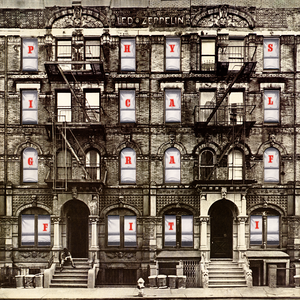Published on Aug 16, 1999
The easiest way to start a fistfight with a Led Zeppelin fan is
to ask them which album they consider to be the group’s best — and
then argue for a different album.
Of late, there has been a lot of attention drawn to their sixth
album (and only studio effort that was a double-album), 1975’s
Physical Graffiti. While most fans will point to “Stairway
To Heaven” as being the most influential Led Zeppelin tune, other
critics have looked towards “Kashmir” as being the ultimate song
that defined the band. Whatever side of the fence you stand on,
there’s no denying that
Physical Graffifi is a highwater mark for a band who prided
themselves on excellence.
Physical Graffiti seems to be the melting pot of all the
different musical influences and styles that Robert Plant, Jimmy
Page, John Paul Jones and John Bonham had been playing and
experimenting with since their formation in 1968. You’ve got your
balls-out blues, introspective light works, Middle Eastern rhythms
and all-out rock — and it never has sounded better coming from
this band.
The blues influences are strong on cuts like “Custard Pie,” the
album’s opener, and “In My Time Of Dying,” which almost sounds like
a Delta blues track at times (though I’ll admit this isn’t a 12-bar
blues, it has the emotion and raw nerves of the style). For a more
acoustic, down-home approach, you just need to turn to “Black
Country Woman,” a track I often wish would never end. The groove
that Plant and Page weave (leading to Jones and Bonham joining in)
is intense, but gentle — and is an inspired moment captured by
engineer Eddie Kramer.
For a lighter touch, you need to turn only to the first half of
the second disc (or, if you still have the records, side three),
for a powerful selection of tracks. “In The Light” is experimental
for Led Zeppelin, almost giving Jones some extra room to noodle
with the keyboards (something the band would grant him more room on
with
In Through The Out Door). “Bron-Yr-Aur” could well be the
prettiest two minutes of guitar work that Page ever recorded; the
way the notes rise from his acoustic guitar make it seem like a
bird flying (an image alluded to in the movie
The Song Remains The Same). Leading into “Down By The
Seaside,” “Bron-Yr-Aur” is a powerful bridge leading to a song
where Led Zeppelin show they can still demonstrate power without
necessarily cranking up the volume.
“Ten Years Gone” closes out the suite, again allowing the band
room to experiment with a sound they’re not normally known for —
in this case, you could almost call it “easy listening,” though I
don’t remember ever hearing a song on “light FM” with this kind of
oomph.
“Kashmir,” the culmination of Plant and Page’s fascination with
Middle Eastern music (at least during the life of Led Zeppelin), is
getting dangerously close to the level of overexposure on radio
these days, but it still remains one of the best Led Zeppelin songs
of all time. The secret weapon here is not Plant’s vocals or Page’s
Danelectro work — instead, it could well be Bonham’s drumming…
simple, but intricate.
And lest you think that Led Zeppelin forgot how to rock and
roll,
Physical Graffiti offers evidence to the contrary. Tracks
like “Night Flight,” “Trampled Under Foot,” “The Wanton Song,”
“Boogie With Stu” (which harkens back to the early days of rock)
and “Sick Again” all deliver one-two punches to the listener’s
eardrums.
If someone were to argue with me that
Physical Graffiti is the best Led Zeppelin album ever, I
wouldn’t argue. Instead, I’d buy the guy a beer, head to the
jukebox, and play the whole damn album through, all 15 tracks. If
this isn’t the best Led Zep album, it’s gotta be in a tie.
